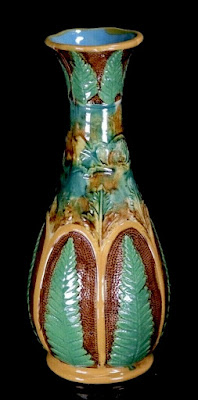William Brownfield entered the pottery trade in 1836 when he partnered with Noah Robinson and and John Wood to take over the Cobridge Pottery. In 1841 The Robinson family left the pottery leaving the firm to identify itself as Wood & Brownfield. In 1850 Wood retired and the pottery was named simply Brownfield. The company was a large one employing over 450 employees.
In 1871 Brownfield exhibited his first majolica wares and brought his son William E. into the firm to become Brownfield & Son. William Brownfield died in 1873 leaving the pottery to the care of his son. In 1876 another son joined the pottery and three years later the third son joined forming Brownfield & Sons. The company continued to grow to over 600 employees through the 1880s.
Brownfield first exhibited majolica at the 1871 London Exhibition. Initial majolica examples include designs registered earlier and made in other bodies.
Much of Brownfield majolica has a distinctive look because of the pale ochre body used by the company and also because of many of the colored glazes used which had a different character from other majolica made during this time. Interiors were often left with clear glazes that highlight the color of the body or Persian blue/cyan instead of the pink which was more common. The thick glazes used were also often opaque or translucent as opposed to the transparent glazes used by other potteries. The color combination of green, deep cadmium yellow, brown and cyan was common among Brownfield pieces along with a very deep navy, and opaque pale canary yellow that were unique to the ware.
The similarity between the many rustic pieces created by the company implies a specialty line created and most likely marketed under a unique brand name within the company’s oeuvre.
Figures often had skin tones covered with a clear glaze allowing the pale ochre body to show through.
Brownfield used several different marks in the course of their history to designate their ware but the two below are the most commonly found on majolica ware. Ink marks, which were common on other bodies, were not used.
The company was dissolved in 1892 and reorganized as the Brownfield Guild Pottery and then again in 1897 as the Brownfield Pottery Ltd. but neither was a success.The company was sold in 1900 and demolished two years later. The Myott pottery was later built on the ground occupied by the Brownfield pottery.




































































































